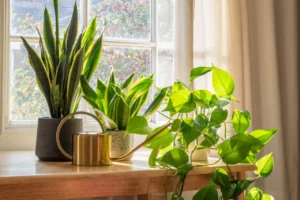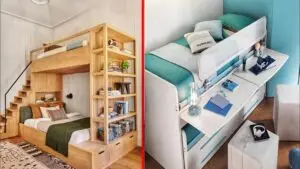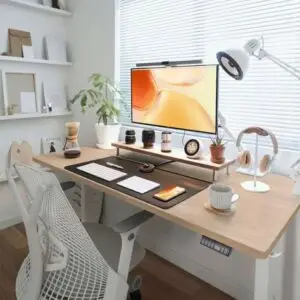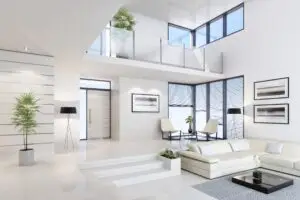Indoor Plant Décor can turn a bland room into a vibrant sanctuary. Plants bring life, color, and calm. In just one glance, your space feels more alive. When you breathe easier, feel calmer, and see growth, you know green has done its magic. In this guide you will learn how to style plants, choose the right types, arrange them beautifully, and care for them long term. You’ll see how to transform your home with indoor plant décor, deepening your connection to nature while building a soothing, healthy space.
1. The Science and Psychology of Green Spaces
Plants are more than pretty objects. They clean the air, they calm your mind, and they deepen your bond with nature. Research shows plants reduce airborne toxins, improve humidity balance, and remove volatile organic compounds (VOCs). The NASA Clean Air Study showed that certain indoor plants filter harmful chemicals like formaldehyde and benzene from air.
On the mental side, exposure to greenery lowers stress hormones like cortisol, improves attention span, and uplifts mood. Many people feel more productive when working near plants. The field of biophilic design seeks to weave nature into architecture and interiors, believing humans have an innate need to connect with the natural world. Using plants indoors is one of the purest ways to bring nature inside. Biophilic interiors boost well-being, creativity, and comfort.
2. Choosing the Right Indoor Plants for Your Space
2.1 Understand Your Environment
First, study your space. How much light does each room get? Is it low, medium, or bright? South or west windows offer bright light; north offers low light. Next consider temperature and humidity. Most homes run 18-26 °C and low humidity. In winter, heating dries air. Some plants resent that. Room size and airflow matter too. A tiny corridor may not support a big leaf plant. A drafty spot near AC may stress delicate foliage.
2.2 Easy-to-Grow Plants for Beginners
Here is a helpful table of beginner-friendly plants:
| Plant Name | Light Needs | Watering Frequency | Best Room Type |
| Snake Plant | Low to Medium | Every 2–3 weeks | Bedroom, Office |
| Pothos | Low to Bright | Weekly | Living Room |
| ZZ Plant | Low | Every 3–4 weeks | Hallway |
| Peace Lily | Medium | Weekly | Bathroom |
These plants survive low light, erratic watering, and still look appealing. They make great starters for indoor plant décor.
2.3 Statement Plants for Style Impact
Once you are comfortable, you can bring in statement plants. Fiddle Leaf Fig gives dramatic, large glossy leaves. Monstera Deliciosa (Swiss cheese plant) has bold cut leaves. Bird of Paradise offers tall leaves and tropical appeal. Use height and leaf texture for drama. Place a tall plant in an corner to draw the eye upward. Combine big-leaf and fine-leaf plants for balance.
3. Styling Secrets: How to Use Plants as Living Décor
3.1 Placement Principles
Decide whether a plant is a focal point (centerpiece) or a background filler. A focal plant might stand in a corner or near a window. Fillers support it, softly echoing shapes. Use symmetry when you want formal balance. Two matching plants flanking a sofa or bed give calm order. For contrast, place a leafy plant beside a sleek modern chair. Layering sizes—from tall floor plants to small tabletop greens—creates natural flow and avoids a static look.
3.2 Styling by Room Type
In the living room, choose large statement plants or corner fillers. Hanging plants or trailing vines add softness above furniture. In the bedroom, pick calming, low-maintenance plants (like snake plant or peace lily) to promote better air and restful sleep. In the kitchen, herbs or moisture-loving species like ferns work well. They thrive near sinks or windows and are also functional. In the bathroom, tropical plants that appreciate humidity, like spider plant or Boston fern, love moist air. In a workspace, use compact, low-maintenance species (ZZ plant, small succulents) that uplift focus without demanding much care.
3.3 Styling by Aesthetic
Each decor style has a plant language. In a minimalist interior, opt for simple shapes and a few statement greens. In a Bohemian space, mix textures, colors, and hanging plants. For Scandinavian style, use white pots, light wood, and crisp greens. In modern designs, go for sleek containers in black, metal, or matte finishes. For rustic interiors, terracotta pots, woven baskets, and natural containers bring warmth. Match foliage tones with wall color and pot color. Neutral walls let green be the star; colored walls require foliage contrast.
4. Creative Plant Display Ideas
Try a vertical garden on a wall. Use wall-mounted planters in staggered layout. This adds greenery without eating floor space. Macramé hangers are stylish and let plants float above. Terrariums — glass jars with small plants — make mini ecosystems. Window ledges make perfect spots for small pots in a row. Repurposed containers—old jars, teacups, baskets—add charm and sustainability. On tabletops, cluster three plant pots of varied heights to create a mini view. Use odd numbers for a natural look. These displays turn plants into living art.
5. Care & Maintenance: Keeping Plants Healthy Indoors
Watering is critical. Overwatering leads to root rot. Always ensure good drainage. Use pots with holes and let excess water escape. Choose proper soil: light, well-aerated mixes (peat, perlite, bark) work best. Fertilize during growing months (spring, summer) with balanced liquid or granule plant food. For pests, use natural remedies: neem oil, insecticidal soap, wiping leaves. Seasonal care means adjusting watering and light as daylight changes. In winter, less water, more shade; in summer, more humidity and possibly pest vigilance. Common stress signs: yellow leaves, droop, brown tips. To revive, cut off damaged parts, repot if root bound, adjust watering or lighting.
6. Indoor Plant Décor Trends in 2025
Smart planters are rising. These containers have self-watering, sensors for light and moisture, and connect to apps to guide you. Hydroponics is entering interiors—soilless setups on shelves or in cabinets. Eco-luxury décor links sustainability with beauty: recycled pots, biodegradable containers, native plants. Influencers show setups with moss walls, living ceilings, and plant corridors. Designers now feature green walls as interior partitions. These trends show how indoor plant décor is evolving.
7. Real-World Case Studies
In a small city apartment, the owner used plant zoning—grouping plants by light level and theme, creating “green pockets” in corners and shelves. A once flat living room gained depth. In a minimalist home, neutral walls and simple furniture were balanced by rich green plants. The plants added warmth, contrasting textures. In a workspace, designers used succulents, ferns, trailing vines and arranged them near desks and windows. The result: the staff reported improved mood, better concentration, and less fatigue.
8. Expert Tips & Common Mistakes to Avoid
One big mistake is overwatering. Even if soil looks dry on top, deeper roots may still be damp. Wrong light choice is another: putting a low-light plant in brightest sun can scorch leaves. Cluttered displays confuse the eye — leave breathing space around each plant. Rotate plants regularly so all sides grow evenly. Botanists advise checking root health yearly and repotting when needed. Stylists suggest matching pot scale to plant size (too large pot looks awkward). These insider hacks help your greenery thrive and your decor shine.
Conclusion
Indoor plant décor offers more than beauty. It heals air, soothes your spirit, and connects your home to nature. Whether you start with one pot or a full green wall, each step is progress. Care attentively, style creatively, and enjoy watching your space and mood transform with indoor plant décor.
FAQs
| Question | Answer |
| What is indoor plant décor? | It is using indoor plants purposefully as decorative elements to enhance interior space and wellness. |
| How much light do indoor plants need? | It depends: low (few hours or indirect), medium (bright but not direct), or bright (direct sun). Know your plant type. |
| Can I keep plants in a bathroom? | Yes. Choose tropical, humidity-loving species. Ensure some indirect light is present. |
| How often should I repot plants? | Usually every 1–2 years or when roots crowd the pot. |
| Do indoor plants improve air quality? | Yes. Many indoor plants filter toxins and add humidity, improving air quality indoors (per studies like NASA’s). |






One thought on “The Ultimate Guide to Indoor Plant Décor — How to Style, Care and Transform Your Space Naturally”